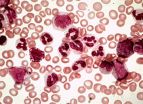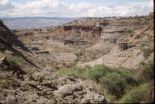(Press-News.org) An international team, headed by researchers at the University of California, San Diego School of Medicine, has identified a key enzyme in the reprogramming process that promotes malignant stem cell cloning and the growth of chronic myeloid leukemia (CML), a cancer of the blood and marrow that experts say is increasing in prevalence.
The findings are published in the Dec. 24 online early edition of the Proceedings of the National Academy of Sciences (PNAS).
Despite the emergence of new therapies, such as tyrosine kinase inhibitors, CML and other leukemias remain problematic because some cancer stem cells avoid destruction and eventually regenerate themselves, a stem cell process known as self-renewal that can result in a return and spread (metastasis) of the disease.
In the PNAS paper, principal investigator Catriona H. M. Jamieson, MD, PhD, associate professor of medicine at UC San Diego, with colleagues in the United States, Canada and Italy, report that inflammation – long associated with the development of cancer – boosts activity of an enzyme called adenosine deaminase or ADAR1.
Expressed during embryogenesis to help blood cell development, ADAR1 subsequently turns off and is triggered by viral infections where it protects normal hematopoietic stem cells from attack. In leukemia stem cells, however, overexpression of ADAR1 enhances the missplicing of RNA, which leads to greater self-renewal and therapeutic resistance of malignant stem cells.
The findings build upon previous studies by Jamieson and others that elucidate the effects of RNA missplicing and instability. "People normally think about DNA instability in cancer, but in this case, it's how the RNA is edited by enzymes that really matters in terms of cancer stem cell generation and resistance to conventional therapy."
The described RNA editing process, which occurs in the context of human and other primate specific sequences, also underscores the importance of addressing inflammation as "an essential driver of cancer relapse and therapeutic resistance," Jamieson said. It also presents a new target for future therapies.
"ADAR1 is an enzyme that we may be able to specifically target with a small molecule inhibitor, an approach we have already used effectively with other inhibitors," said Jamieson. "If we can block the capacity of leukemia stem cells to use ADAR1, if we can knock down that pathway, maybe we can put stem cells back on the right track and stop malignant cloning."
CML is a cancer initiated by a mutant gene called BCR-ABL in blood forming stem cells that leads to an expansion of white blood cells and their precursors. It is typically slow-growing and often not diagnosed until its later stages when there can be a sudden, dramatic increase in malignant cells, known as blast crisis. Median age of diagnosis is 66 years; incidence of the disease increases with age. Despite tremendous advances in BCR-ABL tyrosine kinase inhibitor therapies, the majority of patients relapse if therapy is discontinued, in part as a result of dormant cancer stem cell resistance. This work suggests a novel mechanism for overcoming cancer stem cell resistance to therapy that may prevent relapse and progression.
The estimated prevalence of CML in the United States is 70,000 persons with the disease, projected to steadily increase to approximately 181,000 by 2050. CML is initiated by the mutant BCR-ABL gene, but scientists have not yet identified the cause of the mutation.
INFORMATION:
Co-authors are Qingfei Jiang, Leslie A. Crews, Angela C. Court, David J. Goff, Anil Sadarangani and Sheldon R. Morris, Stem Cell Program, UCSD Department of Medicine and UCSD Moores Cancer Center; Christian L. Barrett, UCSD Division of Genome Information Sciences, Departments of Pediatrics; Hye-Jung Chun, Michael Smith Genome Sciences Centre, Vancouver; Jane M. Isquith, Stem Cell Program, UCSD Department of Medicine, UCSD Moores Cancer Center and Department of Animal Science, California Polytechnic State University; Maria A. Zipeto, UCSD Department of Medicine, UCSD Moores Cancer Center and Department of Experimental Medicine, University of Milano-Biocca, Italy; Mark Minden, Princess Margaret Hospital, Toronto, Canada; Jessica M. Rusert and Lawrence S.B. Goldstein, UCSD Department of Cellular and Molecular Medicine and Howard Hughes Medical Institute; Kim-Hien T. Dao, Oregon Health and Science University Knight Cancer Institute; Marco A. Marra, Michael Smith Genome Sciences Centre, Vancouver; and Kelly A. Frazer, UCSD Division of Genome Information Sciences, Departments of Pediatrics.
Funding for this research came, in part, from California Institute for Regenerative Medicine grants RN2-00910-1 and DR1-01430, CIRM training grant TG2-01154, CIRM SEED grant RS1-00228-1, the Government of Canada through Genome Canada and the Ontario Genomics Institute and the Canadian Institute of Health Research and the Ratner family foundation.
Enzyme accelerates malignant stem cell cloning in chronic myeloid leukemia
2012-12-25
ELSE PRESS RELEASES FROM THIS DATE:
Big transfusions add risk for heart attack patients with anemia
2012-12-25
PROVIDENCE, R.I. [Brown University] — When heart attack patients present in the emergency department with some degree of anemia, or anemic patients have a heart attack, physicians have a tendency, but not much guidance, about whether to provide a blood transfusion. The idea is that a transfusion could help more oxygen get to the heart. Recent national guidelines suggested that there simply isn't good evidence to encourage or discourage the common practice, but a new meta-analysis of 10 studies involving more than 203,000 such patients comes down on the side of it increasing ...
Fluctuating environment may have driven human evolution
2012-12-25
UNIVERSITY PARK, Pa. -- A series of rapid environmental changes in East Africa roughly 2 million years ago may be responsible for driving human evolution, according to researchers at Penn State and Rutgers University.
"The landscape early humans were inhabiting transitioned rapidly back and forth between a closed woodland and an open grassland about five to six times during a period of 200,000 years," said Clayton Magill, graduate student in geosciences at Penn State. "These changes happened very abruptly, with each transition occurring over hundreds to just a few thousand ...
Amazon deforestation brings loss of microbial communities
2012-12-25
AMHERST, Mass. – An international team of microbiologists led by Klaus Nüsslein of the University of Massachusetts Amherst has found that a troubling net loss in diversity among the microbial organisms responsible for a functioning ecosystem is accompanying deforestation in the Amazon rainforest.
Nüsslein, an expert in tropical rain forest microbial soil communities, says, "We found that after rainforest conversion to agricultural pastures, bacterial communities were significantly different from those of forest soils. Not only did the pasture soils show increased species ...
Elevated levels of C-reactive protein appear associated with psychological distress, depression
2012-12-25
CHICAGO – Elevated levels of C-reactive protein, a marker of inflammatory disease, appear to be associated with increased risk of psychological distress and depression in the general population of adults in Denmark, according to a report published Online First by Archives of General Psychiatry, a JAMA Network publication.
Depression is one of the leading causes of disability and previous studies suggest that low-grade systemic inflammation may contribute to the development of depression. C-reactive protein (CRP) is a commonly used marker of inflammation, and inflammatory ...
Study: Blood transfusion associated with increased risk of death for patients with heart attack
2012-12-25
CHICAGO – A meta-analysis of 10 studies suggests that receipt of a blood transfusion among patients with myocardial infarction (heart attack) was associated with increased all-cause mortality compared with not receiving a blood transfusion during heart attack, according to a report published Online First by Archives of Internal Medicine, a JAMA Network publication.
Therapeutic measures including anticoagulation and antiplatelet drugs have "revolutionized" the approach to acute coronary syndrome and improved clinical outcomes. However, some of these therapies may also ...
Study examines overuse of ambulatory health care services in United States
2012-12-25
CHICAGO – An analysis of nationally representative survey data found significant improvement in the delivery of underused care, but more limited changes in the reduction of inappropriate care in ambulatory health care settings between 1998 and 2009, according to a report published Online First by Archives of Internal Medicine, a JAMA Network publication.
"Given the rising costs of health care, policymakers are increasingly interested in identifying the inefficiencies in our health care system," the authors write as background. "The objective of this study was to determine ...
Children with chronic conditions increasingly use available resources in children's hospitals
2012-12-25
CHICAGO – Children with chronic conditions increasingly used more resources in a group of children's hospitals compared with patients without a chronic condition, according to a report that analyzed data from 28 U.S. children's hospitals between 2004 and 2009, and is being published Online First by Archives of Pediatrics & Adolescent Medicine, a JAMA Network publication.
To compare inpatient resource use trends for healthy children and children with chronic health conditions of varying degrees of medical complexity, Jay G. Berry, M.D., M.P.H., with Children's Hospital ...
Why some grasses evolved a more efficient photosynthesis and others didn't
2012-12-25
PROVIDENCE, R.I. [Brown University] — Even on the evolutionary time scale of tens of millions of years there is such a thing as being in the right shape at the right time. An anatomical difference in the ability to seize the moment, according to a study led by Brown University biologists, explains why more species in one broad group, or clade, of grasses evolved a more efficient means of photosynthesis than species in another clade did.
Their findings appear this week in the Proceedings of the National Academy of Sciences.
Biologists refer to the grasses that have evolved ...
Deforestation in the Amazon equals net losses of diversity for microbial communities
2012-12-25
Research from an international team of microbiologists has revealed a new concern about deforestation in the Amazon rainforest – a troubling net loss in the diversity among the microbial organisms responsible for a functioning ecosystem.
The group, which includes professors from The University of Texas at Arlington, University of Oregon, University of Massachusetts, Michigan State University and University of Sao Paulo, sampled a 100 square kilometer area, about 38 square miles, in the Fazenda Nova Vida site in Rondônia, Brazil, a location where rainforest has been converted ...
Grauer School Hosts Film Screening of Sundance Film Festival Documentary, "Miss Representation"
2012-12-25
The Grauer School will host the film screening and post-film discussion of "Miss Representation" on Thursday, January 17, 2013, at 6:00 pm in the Great Hall on the school campus located at 1500 S. El Camino Real in Encinitas. Writtten and directed by Jennifer Siebel Newsom, the 90-minute inspiring documentary priemered at the 2011 Sundance Film Festival and reveals how all forms of media (television, feature films and the internet) contribute to the under-representation of women in American leadership positions and an over-emphasis on youth and beauty. Stories ...




